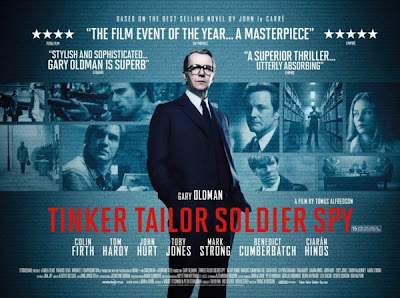Tinker, Tailor, Soldier, Spy 2011 U.K. (127 minutes) directed by Tomas Alfredson, based on the John le Carré novel, screenplay by Bridget O’Connor and Peter Straughan.
Tinker, Tailor, Soldier, Spy does a good job of reliving a moment of the Cold War, and an even better job of capturing novelist John le Carré’s atmosphere and tone, with few bangs of any description.
It is everything but Bond and the Mission Impossible franchise. Rather, like Michael Clayton (2007), this story is about how an institution that preys upon human weakness and is seduced by its self conception is struck a killing blow from within and must rely on one of its own flawed but unseduced members to fix things.
Control (John Hurt), the aging, ailing head man of British Intelligence, had been obsessed by the thought that one of his most senior officials was a double agent working for Soviet Intelligence. He assigned them codenames from a nursery rhyme and taped their photographs to chess pieces.
There is Tinker, Percy Alleline (Toby Jones), who outmaneuvered Control and his rival colleagues when he replaced Control as agency head after a crowning operational disaster in Budapest; Tailor, the ever-charming Bill Haydon (Colin Firth); Soldier, Roy Bland (Ciarán Hinds) and Poor Man, Toby Esterhase (David Dencik).
George Smiley (Gary Oldman) is Spy. Smiley is a patient, bookish man, forced into retirement after Control’s departure. Oliver Lacon (Simon McBurney), a senior civil servant, on instructions from the Minister (Stuart Graham), brings Smiley back to work with a small, handpicked staff operating secretly within British Intelligence against British Intelligence to find Control’s purported ‘rotten apple.’
Smiley and his staff operate in the half-light; they sift through the institutional memory of the half-forgotten and half-believed for half-facts and half-truths that will flush their quarry. The process is like watching skilled players at chess: what two men in coats and ties are doing at a table is nowhere near as interesting as their movements on the board.
It helps to know the game and the moves each piece can make, though the logic of this game defies easy labels and rules. Pieces on the board are moved and traded; pieces that don’t belong are easily relieved of their liberty, limbs, or lives. But on this chessboard, the dots connect: the secret world is too small for them not to.
The dots look something like this:
The nursery rhyme cabal has a highly-placed source inside the Kremlin: something to impress the ever-impatient, ever-distrustful American cousins. Almost as though on cue, this source provides exactly what they want to know.
Control smelled a rat. The game does not work this way. Like Control’s real life contemporary counterpart at CIA, James Jesus Angleton, Control was convinced that a highly-placed mole was giving away the store.
Elsewhere, a ‘scalp hunter’ talent-scouting a high-living Russian KGB thug in Istanbul finds that the thug’s abused female partner has a tale to tell about a high placed double agent. Ah, this is the way the game works; but no one at the home office seems interested. Then chess pieces start zipping around the board like nobody’s business.
Control gets word that a Hungarian general wants to give information relating to the double agent, and he sends Jim Prideaux (Mark Strong), a trusted lieutenant, to meet him. Only one other person knows: Prideaux’s best friend and secret colleague.
All the pieces are now in play. The Devil sits laughing with the secret somewhere in the jumble of God’s details.
In a telling shot sequence after Smiley is put on the case, Control dies, and Smiley is fitted with new bifocals with a look on his face leaving the shop as though to say, ‘the better to see you with, my dears.’ Yet, despite these ‘clarities,’ half-ness is the key. Most of the film is shot in half-light, the colors are half-tones, and much of the dialog is spoken or mumbled in likewise half-tones. As Control ranted, ‘Nothing is genuine anymore!’
At the same time, the camera puts a viewer in the shoes of a spy, hyperattentive and aware of his surroundings. We see this from the start, when the hapless Prideaux walks into a deadly set-up at a sidewalk café in Budapest. Everyone seems to be watching him, including a mother nursing an infant. More than simply self-absorbed paranoia, the preternaturally wary Prideaux senses something is wrong right away. The viewer sees just how wrong it is.
The sudden, shocking outcome in this instance of what turns out to have been a cynically pitiless ruse echoes Le Carré the novelist’s obdurate incredulity that the security of Western democracies is in the hands of people whom elsewhere he has written that a proper religion should have burnt at the stake.
The novel is a masterpiece of the genre, and the 1979 five-hour, seven-episode BBC mini-series, memorably starring Sir Alec Guinness as Smiley, Ian Richardson as Haydon, Michael Aldridge as Alleline, Bernard Hepton as Esterhase, Ian Bannen as Prideaux and Alexander Knox as Control, among many others, is outstanding.
The older movie focused on the personalities of the story’s components, driven by Guinness, with a respectful nod in the direction of Cold War proprieties for who were the good and bad guys. The new version, which bears more than one viewing, would follow Le Carré’s more equivocal assessment of the character of the institution these people made and the role it played in shaping—or disfiguring—the Cold War.


No comments:
Post a Comment